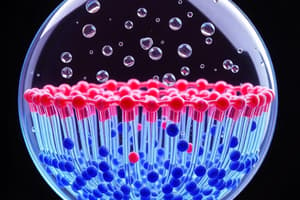Podcast
Questions and Answers
Obligate anaerobes require O2 for growth.
Obligate anaerobes require O2 for growth.
False (B)
Thermophiles are microorganisms that thrive at high temperatures.
Thermophiles are microorganisms that thrive at high temperatures.
True (A)
Facultative anaerobes can only grow in the presence of oxygen.
Facultative anaerobes can only grow in the presence of oxygen.
False (B)
Chemotaxis involves the movement of microorganisms in response to chemical stimuli.
Chemotaxis involves the movement of microorganisms in response to chemical stimuli.
Murein is a type of protein found in the membranes of procaryotic cells.
Murein is a type of protein found in the membranes of procaryotic cells.
Osmophiles grow optimally at low solute concentrations.
Osmophiles grow optimally at low solute concentrations.
Procaryotes can survive under extreme conditions such as varying pH levels.
Procaryotes can survive under extreme conditions such as varying pH levels.
The specialized enzyme system in procaryotes is responsible for DNA replication and cell division coordination.
The specialized enzyme system in procaryotes is responsible for DNA replication and cell division coordination.
Procaryotic flagella are thicker than eukaryotic flagella.
Procaryotic flagella are thicker than eukaryotic flagella.
Bacterial flagella are powered by ATP hydrolysis.
Bacterial flagella are powered by ATP hydrolysis.
All cocci bacteria are motile due to their flagella.
All cocci bacteria are motile due to their flagella.
About 50 genes are required for flagellar synthesis and function.
About 50 genes are required for flagellar synthesis and function.
The M and S rings are located in the outer membrane of bacterial cells.
The M and S rings are located in the outer membrane of bacterial cells.
Flagellar distribution can be used to characterize or distinguish bacteria.
Flagellar distribution can be used to characterize or distinguish bacteria.
Flagella can be either polar or peritrichous.
Flagella can be either polar or peritrichous.
The flagellar filament is not rotated by any motor apparatus.
The flagellar filament is not rotated by any motor apparatus.
Vesicles of the AVC contain wall precursors such as uridine diphosphate N-acetylglucosamine, which is a sub-unit of chitin.
Vesicles of the AVC contain wall precursors such as uridine diphosphate N-acetylglucosamine, which is a sub-unit of chitin.
Fungi primarily contribute to agriculture by causing the majority of animal diseases.
Fungi primarily contribute to agriculture by causing the majority of animal diseases.
The death phase is one of the phases of growth observed in both unicellular and filamentous fungi.
The death phase is one of the phases of growth observed in both unicellular and filamentous fungi.
Wall lytic enzymes in vesicles help to reinforce wall components.
Wall lytic enzymes in vesicles help to reinforce wall components.
The exponential phase is the first phase that occurs in the growth of filamentous fungi.
The exponential phase is the first phase that occurs in the growth of filamentous fungi.
Bacteria are classified as eucaryotic microorganisms.
Bacteria are classified as eucaryotic microorganisms.
The genetic material in procaryotic cells is bound within a nucleus.
The genetic material in procaryotic cells is bound within a nucleus.
Bacteria were the only known type of procaryotic cell for a long time.
Bacteria were the only known type of procaryotic cell for a long time.
Eucaryotic cells have a nuclear membrane.
Eucaryotic cells have a nuclear membrane.
Bacteria have 80S ribosomes in their cytoplasm.
Bacteria have 80S ribosomes in their cytoplasm.
Archaea and bacteria have a circular chromosome topology.
Archaea and bacteria have a circular chromosome topology.
Eucaryotic cells do not contain any organelles.
Eucaryotic cells do not contain any organelles.
Gram-stain reaction is a criterion for identifying procaryotes.
Gram-stain reaction is a criterion for identifying procaryotes.
The cell membrane in bacteria contains sterols.
The cell membrane in bacteria contains sterols.
Streptomycin and chloramphenicol inhibit protein synthesis in eucaryotic cells.
Streptomycin and chloramphenicol inhibit protein synthesis in eucaryotic cells.
Escherichia coli has a typical number of 100-200 common pili per cell.
Escherichia coli has a typical number of 100-200 common pili per cell.
Pseudomonas aeruginosa has polar distribution of cell surface structures.
Pseudomonas aeruginosa has polar distribution of cell surface structures.
The M protein in Streptococcus pyogenes is associated only with DNA transfer.
The M protein in Streptococcus pyogenes is associated only with DNA transfer.
Neisseria gonorrhoeae has a uniform distribution of 100-200 surface structures.
Neisseria gonorrhoeae has a uniform distribution of 100-200 surface structures.
The cell envelope consists of a single layer surrounding the protoplasm of the cell.
The cell envelope consists of a single layer surrounding the protoplasm of the cell.
All cells have a membrane, which is a definitive characteristic of a 'cell'.
All cells have a membrane, which is a definitive characteristic of a 'cell'.
Escherichia coli (sex pilus) mediates surface adherence to epithelial cells.
Escherichia coli (sex pilus) mediates surface adherence to epithelial cells.
The cell wall in Gram-negative bacteria is considered a layered structure.
The cell wall in Gram-negative bacteria is considered a layered structure.
Flashcards are hidden until you start studying
Study Notes
Synthesis and Functions in Microbial Cells
- Membrane lipids include lipopolysaccharide, crucial for Gram-negative cell integrity.
- Murein, or peptidoglycan, constitutes the cell wall, providing structural support.
- Extracytoplasmic proteins undergo assembly and secretion, aiding cellular functions.
- DNA replication and segregation are synchronized with septum formation during cell division.
- Chemotaxis enables bacteria to move towards or away from stimuli, influencing their motility.
- Specialized enzyme systems are strategically located within microbial cells for optimized function.
Physical and Environmental Requirements for Microbial Growth
- Procaryotes thrive in diverse physical conditions, including varying O2 levels, pH, and temperature.
- Thermophiles endure high temperatures; acidophiles thrive in low pH; osmophiles survive in high solute environments.
- Obligate aerobes rely on O2 for growth and utilize it as a final electron acceptor in respiration.
- Obligate anaerobes are harmed or killed by O2, instead deriving energy from fermentation or methanogenesis.
- Facultative anaerobes can switch between aerobic and anaerobic metabolism based on O2 availability.
Overview of Bacteriology
- Bacteria represent a group of single-cell microorganisms with prokaryotic cell structure.
- Prokaryotic DNA is unbound within the cytoplasm, lacking a nuclear membrane, distinguishing them from eukaryotes.
- Bacteriology is the scientific study dedicated to understanding bacteria.
Comparison: Eucarya, Bacteria, and Archaea
- Eucarya cells have a nuclear membrane and more than one linear chromosome; bacteria and archaea have circular chromosomes without a nuclear membrane.
- Bacteria have murein in their cell walls; archaea do not.
- Eucarya have sterols in cell membranes; bacteria and archaea typically do not.
- Ribosome size varies: 80S in eucarya, 70S in bacteria and archaea, indicating fundamental differences in protein synthesis and function.
Identification of Bacteria
- Identification criteria for procaryotes include cell shape, grouping, Gram-stain reaction, and motility.
- Procaryotic flagella are thinner than eukaryotic equivalents, measuring approximately 20 nanometers.
- Flagella are powered by a motor mechanism in the plasma membrane, utilizing proton motive force.
- Flagellar distribution affects motility; configurations can be polar or peritrichous, aiding in species identification.
Bacterial Flagella and Movement
- Approximately 50 genes contribute to flagellar synthesis and functionality.
- The flagellar apparatus comprises several proteins, including basal body rings, hooks, and filaments.
- As the M ring rotates, it propels the bacterium through a turning flagellar filament.
- Flagellar patterns are genetically distinct, serving as identifiers for bacterial species.
Cell Envelope Structure
- The cell envelope encompasses several layers, including the plasma membrane, cell wall, and capsule, protecting the protoplasm.
- The Gram-negative cell wall is structured in layers, critical for maintaining cell integrity.
Importance of Fungi
- Fungi contribute significantly to biodegradation and plant disease processes.
- They play a role in industrial fermentation and the production of biochemicals.
- Commercially cultivated for food sources and beneficial in bioremediation and agricultural practices.
Growth Phases of Fungi
- Unicellular fungi experience a phased growth process: lag, accelerated growth, log, decline, stationary, and death phases.
- Filamentous fungi also follow a similar growth pattern, comprising lag, exponential, stationary, and death phases.
Studying That Suits You
Use AI to generate personalized quizzes and flashcards to suit your learning preferences.




